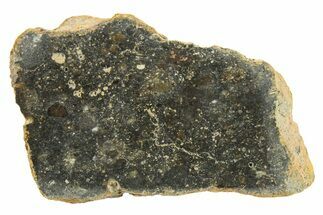This Specimen has been sold.
.75" Polished Rafsa 005 Angrite Meteorite Slice (1.1 g) - Algeria
This is a .75" wide, 1.1-gram thin-sliced piece of the Rafsa 005 angrite meteorite that was collected in Algeria in 2023. It has a gorgeous red-brown coloration, displayed beautifully on its glossy polished surface. It comes in an acrylic display case.
About The Rafsa 005 Meteorite
Rafsa 005 is a rare kind of meteorite: it is an angrite, a class of achondrite that is the oldest volcanic rock known on Earth! These meteorites are basalts aged to about 4.5 billion years with unique oxygen isotope compositions that constrain their origins to the inner solar system. Their parent body was likely a destroyed parent body about the size of the planetoid 4-Vesta. Rafsa 005 is a plutonic variety of angrite, indicating it cooled slowly beneath its parent body's outer crust.
Rafsa 005 was found north of Tindouf, Algeria in 2023, and about 2 kilograms have been recovered. It was subsequently sold to collectors and disseminated onto the commercial market. It is characterized by calcium-rich pyroxenes with occasional diopside and anorthite. Polishing really does this meteorite justice: the interior is full of deep red-brown silicates and tiny mineral grains.
Meteoritical Bulletin Entry: Rafso 005
Rafsa 005 is a rare kind of meteorite: it is an angrite, a class of achondrite that is the oldest volcanic rock known on Earth! These meteorites are basalts aged to about 4.5 billion years with unique oxygen isotope compositions that constrain their origins to the inner solar system. Their parent body was likely a destroyed parent body about the size of the planetoid 4-Vesta. Rafsa 005 is a plutonic variety of angrite, indicating it cooled slowly beneath its parent body's outer crust.
Rafsa 005 was found north of Tindouf, Algeria in 2023, and about 2 kilograms have been recovered. It was subsequently sold to collectors and disseminated onto the commercial market. It is characterized by calcium-rich pyroxenes with occasional diopside and anorthite. Polishing really does this meteorite justice: the interior is full of deep red-brown silicates and tiny mineral grains.
Meteoritical Bulletin Entry: Rafso 005
About Achondrites
Achondrites are a type of stony meteorite that lacks chondrules--round grains that aggregate from molten or partially molten droplets in space to form chondrites. Achondrites still contain grains, but their textures are extremely distinct and analogous with igneous processes rather than the chondrule-producing conditions at the beginning of the solar system.
Achondrites make up about 8 percent of all known meteorites. They are almost all regolith breccias, ejected from impacts on larger asteroids and sometimes the moon and Mars. Most are HED (howardite-eucrite-diogenite) in composition, sourced from the asteroid Vesta: it is the second largest asteroid in the Solar System and the only asteroid visible to the naked eye.
Achondrites are a type of stony meteorite that lacks chondrules--round grains that aggregate from molten or partially molten droplets in space to form chondrites. Achondrites still contain grains, but their textures are extremely distinct and analogous with igneous processes rather than the chondrule-producing conditions at the beginning of the solar system.
Achondrites make up about 8 percent of all known meteorites. They are almost all regolith breccias, ejected from impacts on larger asteroids and sometimes the moon and Mars. Most are HED (howardite-eucrite-diogenite) in composition, sourced from the asteroid Vesta: it is the second largest asteroid in the Solar System and the only asteroid visible to the naked eye.
TYPE
Plutonic Angrite (Calcium-Rich Pyroxene Basalt)
AGE
LOCATION
Near Tindouf, Algeria
SIZE
.75 x .55 x .08", Weight: 1.1 g
CATEGORY
SUB CATEGORY
ITEM
#291767
 Reviews
Reviews












